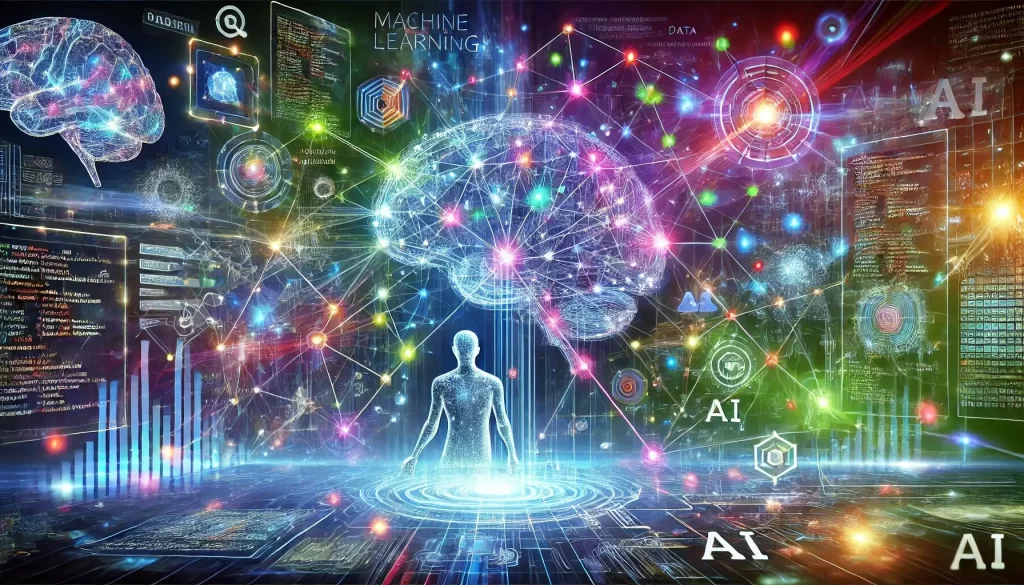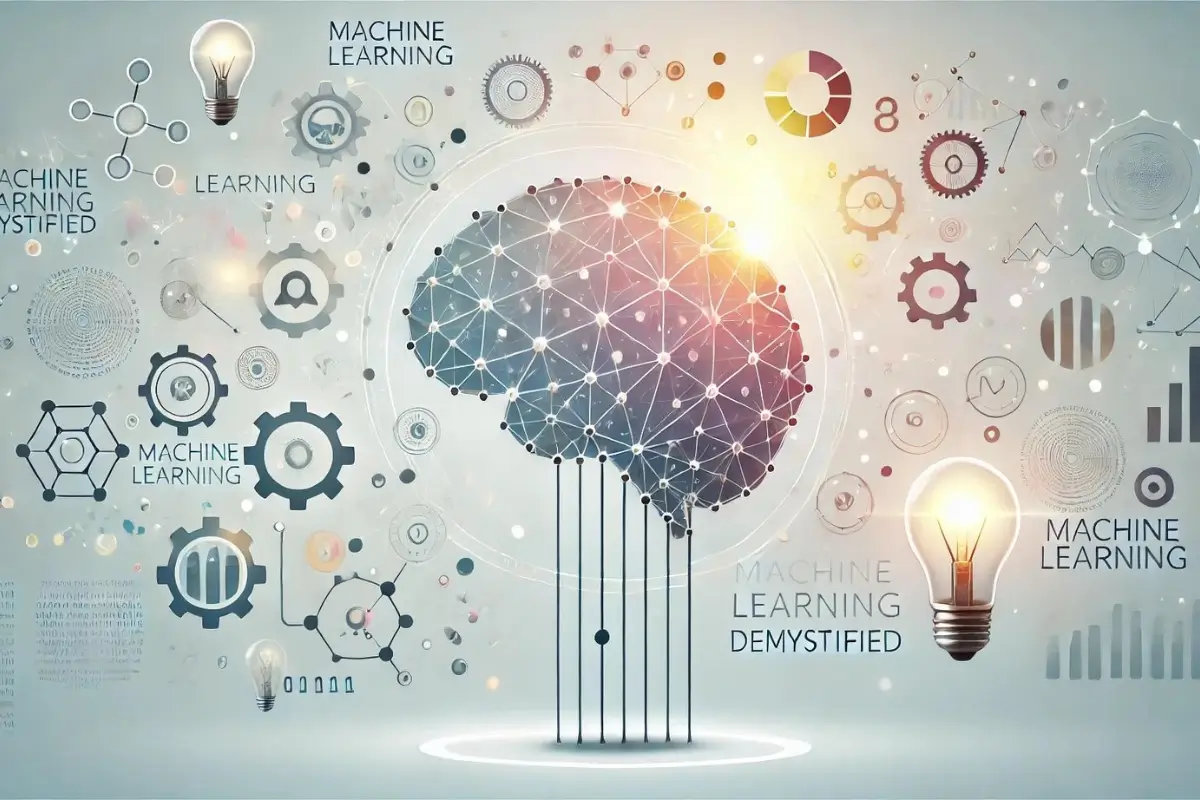Ever wondered how your ride-hailing app predicts your pick-up location or how your social media feed seems to magically know exactly what content will grab your attention? That’s the power behind machine learning (ML) in action. Machine Learning is one subfield within Artificial Intelligence (AI) that lets computers learn without programming. Imagine a computer program that gets more proficient at a task as it learns exactly like you do. This is the premise of machine learning. By ingesting and analyzing data, ML algorithms uncover hidden patterns and relationships, enabling them to make predictions and even automate complex decisions. It makes machine learning a flexible instrument that is applicable to a range of areas, from healthcare and finance to manufacturing and entertainment. Be ready to discover the fascinating machine learning world!
History and Evolution of Machine Learning
Machine learning’s journey isn’t some brand new story. Its roots are further back than you may think! Here’s a whistle-stop tour through the fascinating history and evolution of this field:
- Early Seeds (1940s-1960s): The groundwork was laid in the 1940s with the birth of artificial intelligence research. Alan Turing, a pioneer in computer science, developed his Turing test, which was a standard that a computer’s capability to display human-like intelligence. In the following decades, researchers like Frank Rosenblatt developed early neural networks, laying the foundation for future advancements.
- A Period of Hype and Disillusionment (1960s-1980s): Initial enthusiasm for AI research was dampened by limitations in computing power and theoretical understanding. Machine learning progress stalled for a period.
- The Resurgence and Rise of Powerful Algorithms (1980s-present): The tide began to turn in the 1980s with the development of powerful algorithms like the backpropagation algorithm for training neural networks. This, coupled with the increasing availability of data and computational resources, fueled a renewed surge in machine learning research.
- The Age of Big Data and Deep Learning (2000s-present): The explosion of data in the 21st century, often referred to as “big data,” has been a game-changer for machine learning. Along with advances in deep learning algorithms This has resulted in important breakthroughs in fields like computer vision natural language processing and speech recognition.
Concepts and Terminologies
Machine learning might sound complex, but don’t worry, we’ll break it down! Here’s a quick rundown of essential concepts and terms you’ll encounter on your machine learning journey:
- Algorithms: Think of algorithms as the recipes that power machine learning. These are step-by-step instructions that guide how a machine learns from data. Common algorithms include decision trees, support vector machines, and neural networks.
- Data: Data is the energy that powers machine learning! Data is the basic material that algorithms learn. It can be anything from numbers and text to images and videos. Quality and quantity of information greatly impact how machine-learning models perform.
- Training Data: The Training Data is a certain portion of your data that is utilized to train a machine-learning model. Imagine showing a student a bunch of practice problems before an exam. Training data exposes the model to patterns and relationships within the data.
- Testing Data: Test Data is a distinct collection of data that is used to determine how the model is trained to perform on data that is not seen. Think of it like a last exam for the student. Testing data helps identify any biases or limitations in the model.
- Machine Learning Model: the result of the training process. Models are mathematical representations that reflect the patterns that are learned from training data. This model is a great tool to make predictions or take decisions on unreliable, new data.
- Features: These are the individual characteristics or attributes extracted from your data. For instance, if you’re developing a model to predict the price of homes, some features could include the square footage, number of bedrooms, or the location.
- Overfitting: Imagine a student memorizing every answer on a practice test but failing the final exam because they didn’t truly understand the concepts. Overfitting occurs when a machine remembers its learning data too well and then performs poorly with new data.
- Underfitting: This is the reverse of overfitting. This happens when a model fails to capture the underlying patterns in the training data, leading to poor performance on both training and new data.
Types of machine Learning

Machine learning is not a one-size-fits-all solution. Just like different tools tackle various carpentry tasks, there are distinct categories of machine learning suited for specific problems. Here’s a categorization of the major types of learning:
- Supervised Learning: Imagine a student diligently following a teacher’s guidance. In supervised learning, the algorithm learns from labeled data. Each data point comes with an associated outcome or label, which acts as a clear and concise instruction to the student. The algorithm analyzes the data and the labels, uncovering relationships that enable it to predict labels for new, unseen data. Common applications include spam filtering, image classification (think recognizing faces in photos), and weather forecasting.
- Unsupervised Learning: This is where the student explores on their own! Unsupervised learning works with data that is not labeled, and the algorithm detects hidden patterns or structures in the data. It’s like grouping similar data points together without any predefined categories. Imagine sorting a pile of toys by color or shape – that’s unsupervised learning in action! This type of learning is often used for tasks like customer segmentation (grouping customers with similar characteristics), anomaly detection (finding unusual patterns in data, like fraudulent transactions), and dimensionality reduction (compressing complex data into a more manageable format).
- Semi-Supervised Learning: Imagine a student learning from a combination of a teacher’s guidance and independent exploration. Semi-supervised learning is a way to combine the advantages of both unsupervised and supervised learning, applying a small amount of labeled data with a substantial amount of data that is not labeled. This methodology can be remarkably useful when labeled data is limited but a major amount of unlabeled data is available. For instance, you might have a limited dataset of labeled images of cats and dogs, but a vast collection of unlabeled images. Semi-supervised learning can help the algorithm learn from both sets to improve its image classification capabilities.
- Reinforcement Learning: Think training a dog with treats and rewards. In reinforcement learning, the algorithm interacts with an environment and learns through trial and error. It receives rewards for desired actions and penalties for undesirable ones, constantly refining its strategy to maximize rewards. This type of learning is particularly well-suited for tasks where the environment is dynamic and the optimal course of action is unclear, like training AI agents to play complex games (think beating a human at Go!) or navigating robots in complex environments (like self-driving cars).
Machine Learning Algorithms
We’ve explored different learning styles, but how does the magic actually happen? Machine learning algorithms are the pillars that power the learning process. Each algorithm has its own strong points and limitations, making it appropriate for specific tasks. Here’s a glimpse into some of the most popular algorithms you’ll encounter:
- Linear Regression: Imagine a straight line. Linear Regression is supervised-learning algorithm that determines the most suitable line to describe the relationship between the dependent variable (what is being predicted) along with one or more variables (the variables that influence the prediction). Think of predicting house prices based on factors like size and location. Linear regression is a good starting point for understanding relationships within data, but it can’t capture complex non-linear patterns.
- Decision Trees: Picture a flowchart, with questions at each branch leading to different outcomes. Decision trees are another type of supervised learning algorithm that employs the tree-like structure for classifying information. Imagine a system for classifying email messages to be spammed or by keywords or other information about the sender. Decision trees are simple to comprehend and don’t require an enormous amount of data to train, but they can become complicated for large amounts of data.
- Support Vector Machines (SVM): Think of drawing a clear boundary line to separate different categories. SVMs are supervised learning algorithms adept at classification tasks. They find the optimal hyperplane (a high-dimensional version of a line) that best separates different classes of data points. Imagine categorizing images as either dogs or cats. SVMs can deal with massive data volumes, but they can be expensive to compute for huge databases.
- Neural Networks: Influenced by the brain’s structure Human brain, the neural networks comprise a complicated collection of algorithms They are composed of connected layers of artificial neural cells that can process information. Neural networks are particularly powerful for tasks involving complex patterns, like image recognition or natural language processing (think chatbots). However, they are computationally costly to train and will require a substantial quantity of information.
- Clustering Algorithms: Think of the idea of putting similar objects together. Clustering algorithms are unsupervised algorithms that classify data points according to their similarities without defining categories. This is helpful in tasks such as segmenting customers or for detecting anomalies. There are a variety of methods of clustering that each having strengths and limitations, making the selection dependent on the particular data and the desired result
Machine Learning Tools and Frameworks
Machine learning algorithms are the blueprints, but we need the right tools and frameworks to construct our intelligent systems. Here’s a look at some of the most popular tools and frameworks that empower developers to build and deploy machine learning models:
- TensorFlow: Developed by Google, TensorFlow is a powerful open-source framework for numerical computation and large-scale machine learning. It allows for the creation as well as deploying sophisticated models on different platforms from desktops to mobile devices. TensorFlow is known for its extensive library of pre-built functions and its visual programming tool, TensorFlow Playground, which can be helpful for beginners.
- PyTorch: This open-source framework, backed by Facebook, is gaining traction for its ease of use and dynamic computational graphs. PyTorch allows for more intuitive coding compared to TensorFlow and is often favored for rapid prototyping and research. Its popularity is rising in the natural language processing domain.
- Scikit-Learn: Imagine Scikit-Learn as a Swiss Army Knife to aid machine learning. This open-source Python library provides a comprehensive collection of well-tested algorithms for various tasks, including classification, regression, clustering, and dimensionality reduction. Scikit-learn is a great starting point for beginners due to its user-friendly interface and clear documentation.
- Keras: While technically a high-level API, Keras is often used in conjunction with TensorFlow or other frameworks to simplify the model building process. It offers a user-friendly syntax for defining neural network architectures, making it a popular choice for deep learning applications. Keras can be run on top of TensorFlow, PyTorch, or other frameworks, providing a layer of abstraction.
Applications of Machine Learning

Machine learning isn’t some futuristic fantasy; it’s already making waves across various industries. Here are some compelling examples of how machine learning is revolutionizing the world around us:
- Machine Learning in Healthcare: Imagine AI assisting doctors in diagnosing diseases, predicting patient outcomes, or even personalizing treatment plans. Machine learning algorithms are analyzing medical images to detect abnormalities with higher accuracy, helping in early cancer detection or flagging potential risks during pregnancy.
- Machine Learning in Finance: From fraud detection to algorithmic trading, machine learning is making a splash in the financial sector. Algorithms can analyze vast amounts of financial data to identify suspicious patterns and prevent fraudulent transactions, protecting both financial institutions and consumers.
- Machine Learning in Marketing: Forget one-size-fits-all marketing campaigns. Machine learning personalizes the customer experience by analyzing data to understand preferences and recommend relevant products or services. This targeted approach can significantly improve marketing ROI.
- Machine Learning in Autonomous Vehicles: Self-driving cars are no longer science fiction. Machine learning algorithms are crucial for enabling autonomous vehicles to navigate complex road environments, identifying objects, and making real-time decisions [invalid URL removed].
- Machine Learning in Cybersecurity: The fight against cyber threats is getting smarter. Machine learning algorithms can examine network traffic models to detect irregularities and identify potential cyberattacks in real-time, protecting sensitive data and significant infrastructure.
Challenges and Considerations
Machine learning isn’t a magic bullet. Like any other technology, it comes with its own set of obstacles. Here’s a heads-up on some of the key challenges you might encounter on your machine learning journey:
- Data Quality and Quantity: Imagine building a house on a foundation of sand. Just like the strength of your house depends on the quality of the foundation, the success of your machine learning model hinges on the quality of your data. Incorrect, imperfect, or biased data can lead to defective and unfair model outputs. Quantity also matters. While more data is generally better, training complex models often requires vast amounts of data, which can be expensive and time-consuming to collect and clean.
- Model Interpretability and Transparency: Have you ever wondered how a black box makes decisions? Several machine learning models, specifically the complex ones, can be hard, making it difficult to understand how they arrive at their projections. This absence of interpretability can raise alarms about fairness and bias, especially in sensitive applications. Imagine an AI-powered loan approval system that rejects loan applications for seemingly similar profiles. Without understanding the model’s reasoning, it’s hard to identify and address potential biases.
- Computational Power: Training complex machine learning models can be a computationally intensive task, requiring significant processing power and resources. This can be a barrier for smaller businesses or individual developers who might not have access to high-performance computing clusters. However, advancements in cloud computing and specialized hardware are making it more accessible to train complex models without needing an army of supercomputers.
- Ethical and Privacy Concerns: As machine learning becomes more pervasive, ethical considerations and privacy concerns come to the forefront. Bias in training data can lead to discriminatory outcomes, and the use of personal data for machine learning models raises questions about data security and privacy. It’s crucial to develop and deploy machine learning models responsibly, with fairness, transparency, and accountability in mind.
Future Trends in Machine Learning
Machine learning is a fast progressing field, continually pushing the boundaries of what is possible. Here’s a glimpse into some of the exciting trends that are poised to shape the future of machine learning:
- Explainable AI (XAI): Remember the challenge of opaque models? XAI seeks to tackle this by creating machine learning models more interpretable and transparent. This will allow us to understand how models arrive at decisions, fostering trust and enabling us to identify and mitigate potential biases. Imagine being able to see the reasoning behind an AI-powered medical diagnosis – that’s the power of Explainable AI.
- Federated Learning: Data privacy is a top concern. Federated learning deals in giving a solution by allowing collective training on decentralized datasets. Imagine multiple devices training a model on their local data without directly sharing that data with a central server. This protects privacy while still allowing for the creation of powerful models.
- Automated Machine Learning (AutoML): Not everyone is an expert in machine learning. AutoML is a platform that aims to make machine learning through automation of tasks such as the preparation of data as well as feature engineering and the selection of models. This allows even those with limited technical expertise to leverage the power of machine learning.
- Quantum Machine Learning: While still in the early stages, quantum computing has enormous possibilities for learning machines. Quantum computers rein in the norms of quantum mechanics to perform computations that are intractable for classical computers. This could revolutionize machine learning tasks that require dealing with massive datasets or complex relationships.
The world of machine learning is vast and ever-expanding. It has both challenges and opportunities. While data hurdles, interpretability concerns, and ethical considerations demand thoughtful solutions, the future of machine learning gleams with potential. From the promise of explainable AI to the possibilities of quantum computing, this field is poised to revolutionize various aspects of our lives. So, buckle up and dive into the exciting world of machine learning – you might just be the one to shape its next groundbreaking innovation!
Also read: AI – All You Need to Know

